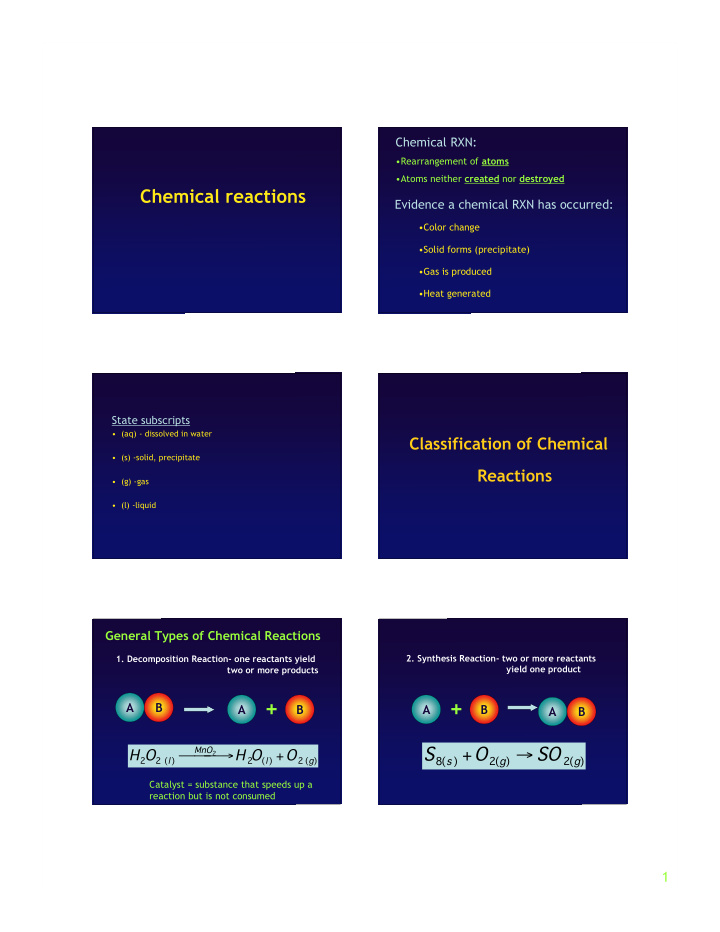



Chemical RXN: •Rearrangement of atoms •Atoms neither created nor destroyed Chemical reactions Evidence a chemical RXN has occurred: •Color change •Solid forms (precipitate) •Gas is produced •Heat generated State subscripts • (aq) - dissolved in water Classification of Chemical • (s) -solid, precipitate Reactions • (g) -gas • (l) -liquid General Types of Chemical Reactions 1. Decomposition Reaction- one reactants yield 2. Synthesis Reaction- two or more reactants two or more products yield one product + + A B A B A B A B S 8( s ) + O 2( g ) � SO 2( g ) MnO 2 H 2 O 2 ( l ) H 2 O ( l ) + O 2 � � � � ( g ) Catalyst = substance that speeds up a reaction but is not consumed 1
3. Single Replacement Reaction- b) metal replaces another metal in a solution: Zn ( s ) + CuSO 4( aq ) � Zn ( s ) + CuSO 4( aq ) � ZnSO 4( aq ) + Cu ( Zn ( s ) + CuSO 4( aq ) � ZnSO 4( aq ) • one element replaces another element in a compound S ) • products are different element and different compound c) active metal replaces H in acid: A + A + Zn ( s ) + HCl ( aq ) � Zn ( s ) + HCl ( aq ) � ZnCl 2( aq ) Zn ( s ) + HCl ( aq ) � ZnCl 2( aq ) + H 2( g ) B C C B a) Halogen replaces the ion of another halogen: d) very active metal replaces H in water: Cl 2( g ) Cl 2(g) + NaI (aq) � I 2(s) + NaCl (aq) Cl 2(g) + NaI (aq) � I 2(s) Cl 2(g) + NaI (aq) � Na ( s ) + HOH ( l ) � NaOH ( aq ) Na ( s ) + HOH ( l ) � Na ( s ) + HOH ( l ) � NaOH ( aq ) + H 2( g ) element compound compound element a. Precipitation reaction- a precipitate forms 4. Double Replacement Reaction- Zn ( NO 3 ) Zn ( NO 3 ) Zn ( NO 3 ) 2( aq ) + Na 2 CO 3( aq ) � NaNO 3( aq ) 2( aq ) + Na 2 CO 3( aq ) � NaNO 3( aq ) + ZnCO 3( s ) 2( aq ) + Na 2 CO 3( aq ) � •Two cations of different compounds swap places •Products are two different compounds NaCl ( aq ) + AgNO 3( aq ) � NaCl ( aq ) + AgNO 3( aq ) � AgCl ( s ) + NaNO 3( aq ) NaCl ( aq ) + AgNO 3( aq ) � AgCl ( s ) Aqueous Aqueous Aqueous precipitate + compound compound compound B + C - A + D - Neutralization reaction- acid + base yield salt and water HCl ( aq ) + NaOH ( aq ) � HCl ( aq ) + NaOH ( aq ) � HO H ( l ) + NaCl ( aq ) HCl ( aq ) + NaOH ( aq ) � HO H ( l ) + B + D - A + C - Aqueous Aqueous Aqueous water base salt acid synthesis decomposition 2
Single replacement Double replacement 5. Combustion- •A reaction in which a C-containing compound is reacted with molecular oxygen Always add O 2 Insert two rxns here: as a reactant One with methanol combusted in • releases enough E to sustain a flame excess O2 Other with C2H2 in limiting O2 a. Complete: more than enough O 2 present CH 4 + O 2 � � CO 2 + H 2 O b. Incomplete: not enough O 2 present CH 4 + O 2 � CH 4 + O 2 � CO + H 2 O Sample problem Aqueous solution of sodium sulfide is mixed with a 1. CaSO 4 + 2 AgNO 3 → Ca(NO 3 ) 2 + 2AgSO 4 DR solution of aluminum chloride producing solid aluminum sulfide and aqueous sodium chloride 2. CaCO 3 (s) → CaO (s) + CO 2 (g) Decomp 1. Write formulas Synth 3. 4 V (s) + 5 O 2 (g) → 2 V 2 O 5 (s) 3 Na 2 S (aq) + AlCl 3 (aq) → 2 Al 2 S 3 (s) + NaCl (aq) 6 SR 4. Cl 2 (g) + 2 NaBr (s) → 2 NaCl (s) + Br 2 (g) 5. Zn (s) + CuSO 4 (aq) → Cu (s) + ZnSO 4 SR 2. Balance 6. H 2 O (l) + Na 2 O (s) → 2 NaOH (aq) Synth 7. KClO 3 (s) → KCl (s) + 3 O 2(g) 3. What type of chemical reaction Decomp Double Replacement 8. FeS (g) + 2 HCl (g) → FeCl 2 (s) + H 2 S (g) DR 3
Aqueous solution of calcium chromate is mixed with Aqueous solution of iron (III) chloride is mixed with a solution of silver nitrate producing solid silver solid copper producing solid iron and aqueous chromate and aqueous calcium nitrate copper (II) chloride 1. Write formulas 1. Write formulas CaCrO 4 (aq) + AgNO 3 (aq) → Ag 2 CrO 4 (s) + Ca(NO 3 ) 2 (aq) 2 2 FeCl 3 (aq) + Cu (s) → 3 2 3 Fe (s) + CuCl 2 (aq) 2. Balance 2. Balance 3. What type of chemical reaction 3. What type of chemical reaction Double Replacement Single Replacement “solid metal” = metal is element not ion Cu (s) not Cu +2 Mg (s) not Mg +2 diatomic elements = H O F Br I N Cl Cl 2 not Cl O 2 not O H 2 not H 4
Recommend
More recommend